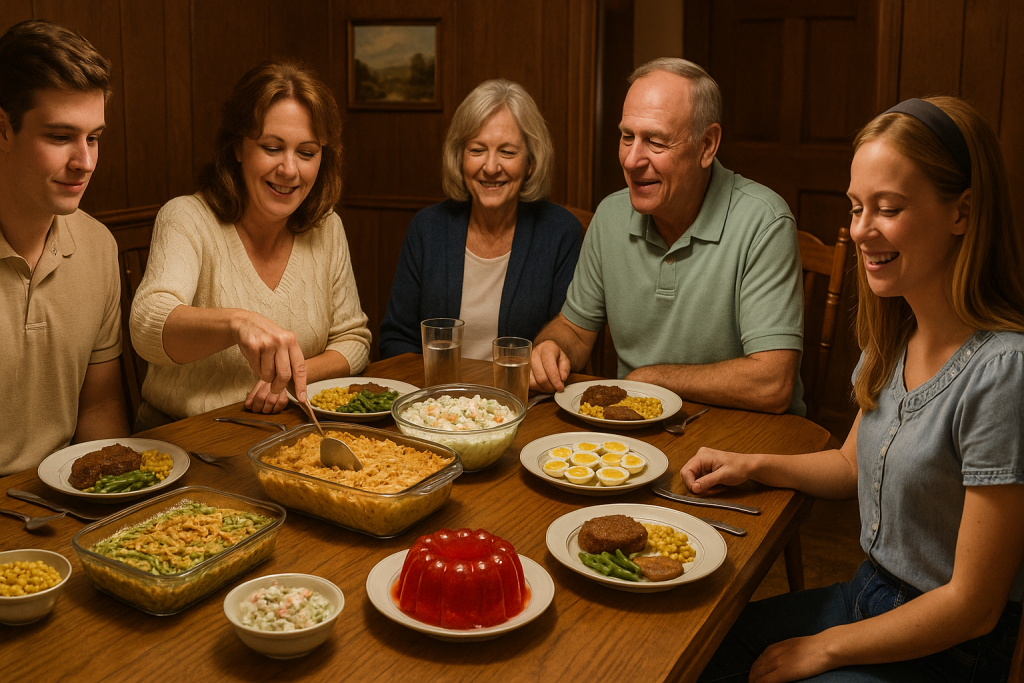There’s a particular silence when the casserole emerges, crowned with its golden armor of crushed Ritz crackers. Younger relatives exchange glances. Older ones beam with pride. This isn’t just dinner—it’s 1985 refusing to die, one cream-of-mushroom soup can at a time.
Every family has them: dishes that achieved permanent status during Reagan’s first term and never left. They survived the fat-free ’90s, the Atkins panic, the kale revolution. Now they sit on modern tables like edible fossils, forcing everyone to pretend that marshmallows on vegetables constitutes cooking.
1. Seven-layer salad (geological monument to mayonnaise)
Behold the trifle dish revealing stratified deposits: iceberg lettuce, frozen peas, bacon bits, and enough mayonnaise to grout a bathroom. This “salad” treats vegetables like specimens trapped in amber, buried under dairy and displayed like the Crown Jewels.
The ritual never changes: someone’s aunt assembles it Thursday night, convinced that lettuce marinating in mayo for twenty-four hours improves something. The nutritional value of iceberg lettuce barely exists, but nutrition isn’t the point. This is architecture.
Each serving destroys the careful stratification, creating mayo chaos on plates. Everyone takes some. Nobody finishes. The dish returns to the fridge to develop that special film only Reagan-era food could achieve.
2. Chicken divan (broccoli’s punishment)
Someone in 1985 decided broccoli needed help—specifically canned soup, mayonnaise, and a cheese blanket. Thus chicken divan: the casserole that treats vegetables like criminals requiring camouflage.
The recipe hasn’t evolved since dominating every community cookbook of the era. Frozen broccoli (never fresh), condensed soup (never actual sauce), curry powder for “sophistication.”
It emerges bubbling, identical to your mother’s version, and hers before that. The broccoli has surrendered all structural integrity. Chicken exists somewhere, theoretically. Everyone declares it “not bad”—1985’s highest praise.
3. Pork chops in mushroom soup (the Crock-Pot’s darkest hour)
Six hours in the slow cooker with Campbell’s finest transforms decent pork into something approaching warm upholstery. The slow cooker revolution peaked here and never apologized.
The recipe card—yellowed, splattered—demands three ingredients: pork chops, soup, faith that time equals flavor. It doesn’t. But tradition demands this beige tribute appear monthly, minimum.
Served over instant rice (Uncle Ben’s being “fancy”), it delivers sustenance without joy. Nobody requests seconds, yet everyone swears it “used to taste better,” though it never did. Memory lies; the pork chops don’t.
4. Jell-O salad (dessert in witness protection)
The lime monument quivers, studded with pears and cottage cheese, crowned with Cool Whip. This isn’t food—it’s what happens when recipes escape from laboratories. Yet it appears, mandatory, wobbling through every gathering.
Gelatin salads once signified suburban arrival, when owning molds meant something. Now it’s what happens when nobody tells Grandma that suspended fruit cocktail stopped being festive during Bush One.
The tragedy? Someone always declares it “refreshing” while others navigate around it like unexploded ordnance, taking just enough to seem grateful. The Jell-O knows. The Jell-O judges.
5. Tuna casserole (the Midwest’s cry for help)
Egg noodles, canned tuna, cream soup, potato chip topping—this is what happened when post-war convenience culture convinced America that cooking meant opening cans. It endures like culinary Stockholm syndrome.
Every family claims their version is “different”—peas here, cheese there, the disturbed add hard-boiled eggs. But it’s all the same beige surrender, the same Tuesday night capitulation.
It fills you up. That’s the kindest review possible. It fills you the way February fills a calendar—gray, inevitable, vaguely fish-scented until Thursday.
6. Beef Stroganoff (McCormick’s Cold War fantasy)
The seasoning packet promised exotic adventure, delivering gray beef drowning in sour cream over noodles that surrendered twenty minutes ago. This was international cuisine when international meant “contains paprika.”
The actual Russian dish would flee the country rather than claim relation to this suburban interpretation. But authenticity wasn’t the goal—the goal was Tuesday sophistication from the regular Kroger.
It materializes at dinners where wine arrives in boxes and conversation dies at property taxes. Everyone performs enthusiasm while calculating DoorDash delivery times. Tomorrow’s Tupperware will require power tools.
Final thoughts
These dishes persist not because they’re good but because they’re ours. They’re what love looked like when both parents worked and cooking meant survival, not artistry. They’re childhood winters, grandmothers measuring care in condensed soup, a time when paprika meant adventure.
The tragedy isn’t that families still serve these—it’s that we’ve lost what made them make sense. In 1985, they represented progress: liberation from scratch cooking, international flavors reaching suburbia, technology delivering dinner in thirty minutes. They were democratic food, achievable food, Tuesday night food.
Now they’re culinary ghosts haunting tables where everyone has phones full of actual recipes, where fresh ingredients exist year-round, where we’ve tasted real Stroganoff. Yet we make them anyway, these monuments to convenience culture, because changing the menu acknowledges that time passed, that people aged, that some chairs are empty now.
And sometimes, when the Jell-O mold emerges and everyone groans with recognition, that denial tastes exactly like home. Even if home tastes like cream of mushroom soup mixed with something that shouldn’t exist.
The dishes aren’t the problem. The problem is we can’t admit why we keep making them.
What’s Your Plant-Powered Archetype?
Ever wonder what your everyday habits say about your deeper purpose—and how they ripple out to impact the planet?
This 90-second quiz reveals the plant-powered role you’re here to play, and the tiny shift that makes it even more powerful.
12 fun questions. Instant results. Surprisingly accurate.


Dining and Cooking